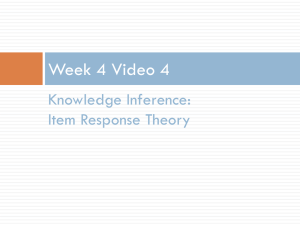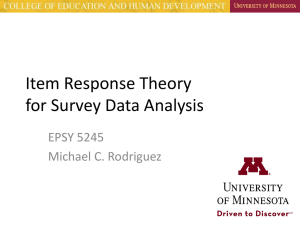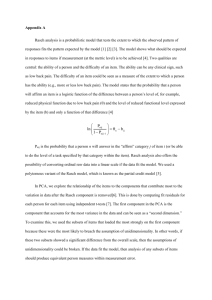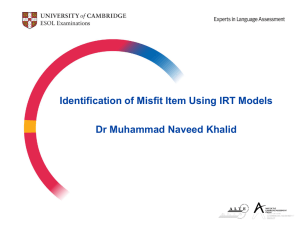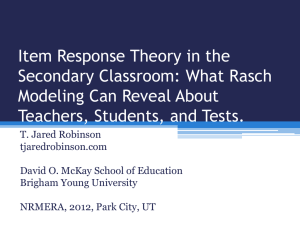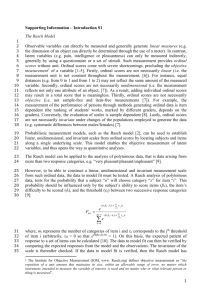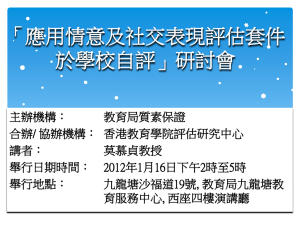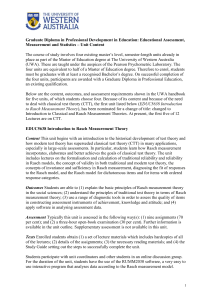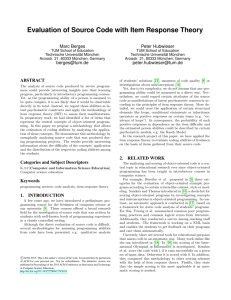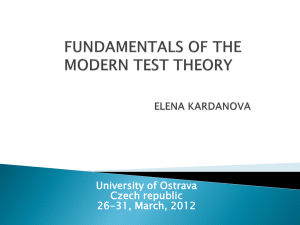An item has three categories (0,1,2)
advertisement
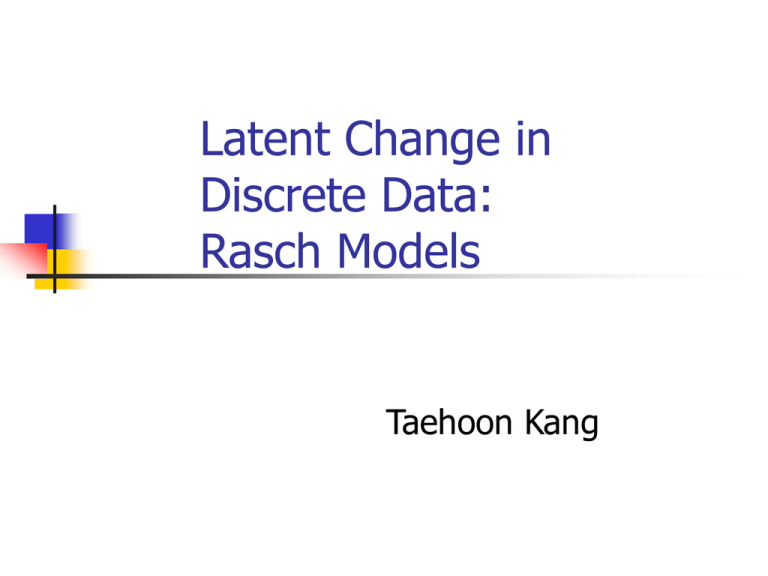
Latent Change in Discrete Data: Rasch Models Taehoon Kang Item Response Theory Modern test theory to analyze test result data in item level Basic Assumptions 1) Unidimensionality 2) Local independence 1) Unidimensionality 0 .6 0 .8 1 .0 Only one latent ability decides item performance of an examinee 0 .0 0 .2 0 .4 P -3 -2 -1 0 theta 1 2 3 2) Local Independence Once the ability influencing item performance is taken into account, the responses to items are statistically independent. P(U1 ,U2 ,…, Un|) = P(U1|) P(U2|) … P(Un|) Unidimensional-Dichotomous IRT 1PL model (Rasch Model): item difficulty 2PL model: item difficulty and discrimination 3PL model: item difficulty, discrimination, and guessing 1 .0 0 .8 0 .6 0 .4 0 .2 0 .0 0 .0 0 .0 0 .2 0 .2 0 .4 0 .4 P P P 0 .6 0 .6 0 .8 0 .8 1 .0 1 .0 << Item Characteristic Curve (ICC) of each model >> -4 -2 0 2 -4 4 -4 -2 0 theta theta 2 4 -2 0 theta 2 4 Unidimensional-Polytomous IRT 1 .0 category 0 0 .6 0 .8 category 2 category 1 0 .4 0 .2 0 .0 Used when items are scored using more than two score categories (graded responses, ordered categories, partial credits; 0,1,2,…m) An item has three categories (0,1,2) P -4 -2 0 theta 2 4 Extensions of Unidimensional IRT 1) Multidimensional IRT models : adding continuous latent ability variables 2) Mixture IRT models : latent subgroups (adding categorical variables) 0 0 .2 P ro b 0 .4 0 .6 0 .8 1 1) Multidimensional IRT models 4 2 4 th e 2 0 ta 2 -2 -2 -4 -4 t 0 1 h e ta 2) Mixture IRT models 0 .6 0 .8 1 .0 When the observed data are generated by two or more latent classes of individuals so that within each class the unidimensional IRT model holds but with different item parameters between the classes, the unidimensional model is generalized to a mixture IRT model. Stragety B class 0 .4 P 0 .2 Strategy A class 0 .0 -4 -2 0 theta 2 4 Rasch Models for Change To apply various IRT models to the analysis of change, this article introduces three models. 1) The Unidimensional Rasch Model 2) The Two-Dimensional Rasch Model 3) The Mover-Stayer Mixed Rasch Model The data structure used in this article Three arithmetic word items at second and third grade I1 0001 0 N= 0002 1 1,030 … 1030 0 T1 I2 0 0 … 0 I3 1 0 I4 1 1 1 1 T2 I5 0 1 … 0 I6 1 1 1 1) The Unidimensional Rasch Model 1 .0 0 .8 0 .6 ICC at T1 0 .4 eta ICC at T2 0 .2 0 .0 This Model assumes the change of all examinee from T1 to T2 are same. Instead of looking at the change of abilities, they say the change of item difficulties(eta) reflects the individuals’ global amount of change on the latent continuum. Every item has same eta. P -4 -2 0 theta 2 4 2) The Two-Dimensional Rasch Model In this model, the estimated ability of an examinee at T1 becomes the first dimension ability and the estimated ability at T2 becomes the second dimension. Through the difference of two estimated abilities, we can get person-specific change. Item difficulty parameters are specified to be invariant over time. 0 .8 1 .0 0 .0 0 .2 0 .4 P 0 .6 ICC at Ti and T2 ability at T1 -4 ability at T2 -2 0 theta 2 4 3) The Mover-Stayer Mixture Rasch Model 0 .6 0 .8 1 .0 There are two latent subgroups. One is the Mover group (c=1) in which ability change occurs. The other is Stayer group (c=2) in which no change occurs. Here, like the unidimensional Rasch Model, It is assumed that every examinee in Mover group has same change from T1 to T2. ICC of Mover and Stayer grops at T1 0 .0 0 .2 0 .4 P -4 -2 0 theta 2 4 0 .8 1 .0 ICC of Mover-Stayer groups at T2 0 .6 ICC of Mover grops at T2 0 .0 0 .2 0 .4 P ICC of Stayer grops at T2 -4 -2 0 theta 2 4 Results (1) Result (2) Questions How can we test the assumption of unidimensionality? - Factor Analysis : 30 % (?) - parallel analysis Scree Plot 4 3 2 E ig e n v a lu e 1) 1 0 1 2 3 Component Number Analysis w eighted by FREQ 4 5 6 7 8 9 Questions 2) In each of three Rasch models for analyzing change introduced in this article, what is going on the individual differences about change? In the unidimensional Rasch model and the Mover-Stayer mixture Rasch Model, they don’t allow individual differences in change. Only in the two-dimensional Rasch model, we could get the person-specific change. Questions 3) In Mover-Stayer Mixture Rasch model, they are dealing with only two latent groups. If this model doesn’t fit the data well, what kind of extensions of latent groups could be possible? Quantitative extensions : stayer/ slow mover /fast mover Qualitative extensions : Stayer who doesn’t have profit from school instruction/ Stayer who, in grade2, can solve items for grade3 well/ Mover whose ability increases well/ Mover who moves backward
